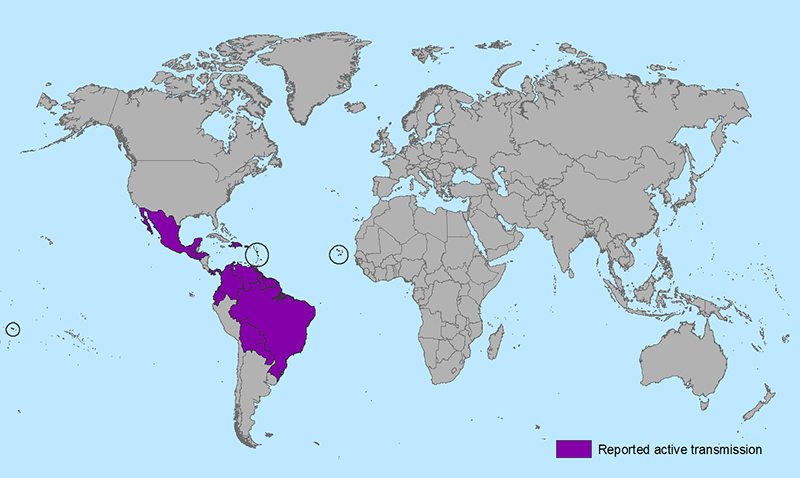“L ast year, the virus was detected in the Americas, where it is now spreading explosively,” Margaret Chan — who is the director general of the World Health Organization — said at an emergency briefing in Geneva pertaining to the Zika viral outbreak. “As of today, cases have been reported in 23 countries and territories in the region. The level of alarm is extremely high” and there is deep concern “about this rapidly evolving situation for four main reasons: first, the possible association of infection with birth malformations and neurological syndromes; second, the potential for further international spread, given the wide geographical distribution of the mosquito factor; third, the lack of population immunity in newly-affected areas; fourth, and the absence of vaccines, specific treatments, and the absence of rapid diagnostic tests.”
Over the next year, there could be as many as four million cases which can reach the potential of a pandemic primarily due to commercial air travel — resulting in an International Health Regulations Emergency Committee of the World Health Organization to be convened “on the Zika virus and observed increase in neurological disorders and neonatal malformations” on Monday, February 1, 2016 in Geneva to ascertain whether the outbreak constitutes a Public Health Emergency of International Concern. “The level of concern is high as is the level of uncertainty.”
This all sounds rather dire; but let us review the facts and information pertaining to the Zika virus.
What Is the Zika Virus?
According to the World Health Organization, Zika virus disease is caused by a virus transmitted by Aedes mosquitoes — which usually bite during the morning and late afternoon or evening hours — which was first identified in rhesus monkeys in Uganda in 1947 through a monitoring network of sylvatic yellow fever. It was subsequently identified in human beings in 1952 in Uganda and the United Republic of Tanzania. Outbreaks of Zika virus disease have been recorded in Africa, the Americas, Asia and the Pacific.
The incubation period — which is the time from exposure to symptoms — of Zika virus disease is unclear at this time; but is likely to be a few days. The symptoms are similar to other arbovirus infections — such as dengue — and include fever, muscle and joint pain, skin rashes, conjunctivitis, malaise, and headache. These symptoms are usually mild and last for two to seven days.”
According to the Centers for Disease Control and Prevention in the United States, severe disease requiring hospitalization is uncommon. Approximately 20 percent of people infected with Zika virus become ill; and deaths as a result of contracting the disease are rare. Serious symptoms are rare as well.
Women who become infected with the Zika virus seem to be at a higher risk of giving birth to babies with a condition called microcephaly, which is a rare neurological condition in which the head of an infant is significantly smaller than the heads of other children of the same age and sex, according to the Mayo Clinic. Sometimes detected at birth, microcephaly usually is the result of the brain developing abnormally in the womb; or not growing as it should after birth.
As a form of prevention, the governments of countries — such as El Salvador and Colombia — are asking women not to become pregnant in periods spanning from the next few months through 2018, according to this article written by Joshua Partlow of The Washington Post.
The Zika virus is transmitted to people through the bite of an infected mosquito from the Aedes genus — mainly Aedes aegypti in tropical regions but can be found as far north as Georgia and South Carolina in the United States — which is the same mosquito that transmits diseases such as dengue, chikungunya and yellow fever.
Countries and Territories with Active Zika Virus Transmission
The virus can be expected to spread further, as the mosquitoes which carry it can be found across the following countries and territories with active Zika virus transmission:
- Barbados
- Bolivia
- Brazil
- Cape Verde
- Colombia
- Dominican Republic
- Ecuador
- El Salvador
- French Guiana
- Guadeloupe
- Guatemala
- Guyana
- Haiti
- Honduras
- Martinique
- Mexico
- Panama
- Paraguay
- Puerto Rico
- Saint Martin
- Samoa
- Suriname
- United States Virgin Islands
- Venezuela
Treatment of the Zika Virus
The Zika virus disease is usually relatively mild and requires no specific treatment. People sick as a result of being infected with the Zika virus should get plenty of rest; drink plenty of fluids to prevent dehydration; and treat pain and fever with common medicines such as acetaminophen or paracetamol — but not medications such as aspirin, ibuprofen and naproxen.
If symptoms worsen, you are strongly advised to seek medical care and advice.
There is currently no vaccine or official treatment available at this time.
What the World Health Organization Intends to Do
The World Health Organization is supporting countries to control the Zika virus disease through the following steps:
- Strengthen surveillance
- Build the capacity of laboratories to detect the Zika virus
- Work with countries to eliminate mosquito populations
- Prepare recommendations for the clinical care and monitoring of people diagnosed with the Zika virus infection
- Define and support priority areas of research into the Zika virus disease and possible complications emanating from it
What You Can Do
“The latest travel advice remained a Level 2 advisory, meaning it concerns only travelers with specific risk factors — in this case, pregnancy”, according to this article written by Catherine Saint Louis of The New York Times. “But Guillain-Barré syndrome, a potentially life-threatening paralysis, has been found in men and women with probable Zika infection in Brazil and French Polynesia.”
It is strongly recommended that you see your healthcare provider if you develop the aforementioned symptoms and have visited an area where Zika is found; and tell your healthcare provider when and where you recently traveled.
The most effective form of prevention is to proactively protect yourself against mosquito bites — in order to both prevent contracting the Zika virus disease and to prevent its spread if you are already infected — with the following steps:
- Use insect repellent
- Wear clothes — preferably with light colors — which cover as much of your body as possible
- Use physical barriers such as screens, closed doors and windows
- Sleep under mosquito nets
- Empty, clean or cover containers which can hold water — such as buckets, flower pots or tires — so that places where mosquitoes can breed are removed
- Young children, sick people and elderly people are three examples of those who may not be able to protect themselves adequately and could use assistance and special attention
Summary
The chances of a healthy individual person being adversely affected by the Zika virus seems to be minimal at best — but awareness and proactive prevention are still necessary to mitigate the spread of this virus to other people.
You cannot contract the Zika virus from a person who is infected; but people are the source for spreading the virus — similarly to malaria, as transmission is via mosquito.
Although you should not consider curtailing your travel plans if you are a healthy individual, airlines have been known to offer refunds or waivers of fees for changes in itineraries to countries and territories with active Zika virus transmission. If you are concerned or are someone who could be affected by this virus, this is your opportunity to alter your travel plans accordingly without penalty.

